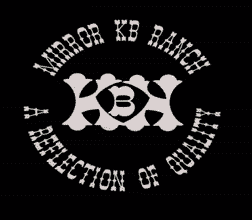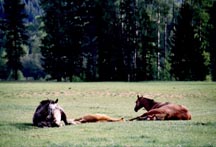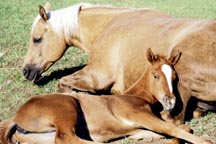 |
Mirror KB Articles
|
 |
Mirror KB Articles
|
Mirror KB Equine Article Series
Hitting the Hay
Article and Photos by Kim and Kari Baker

Ever wondered about the amount of time your horse spends snoozing?
Compared to people, horses seem to require very little actual sleeping time. While we consider a healthy night's sleep of eight hours to be about right for us, how much sleep do our horses actually need? Generally occurring during the night time hours, the average horse spends any where from a few minutes to as much as 3 or 4 hours per day actually sleeping, with another 2 t0 3 hours per day relaxing in a standing drowsy state. In the wild, horses sleep less than their domestic counterparts. Much of this difference seems to be tied to the availability of feed. The wild horse spends much of his time foraging for his own food, sometimes traveling great distances in his pursuit, preferring to pause during the hottest time of the day to doze. On the other hand, the domestic horse is often confined in a stall and his daily existence feeding, exercise, and socialization is vastly controlled by his owner. He is therefore forced to time his sleep cycle at night, coinciding his periods of rest to the human schedule. Domestic horses kept on pasture fit somewhere in between the stalled horse and the free roaming wild horse. Though not a strict rule in the domestic horse, groups of horses in pasture situations seem to mimic their wild counterparts by taking turns lying down to sleep. While a few lie down to sleep, one or two herd members will remain alert on their feet, acting as sentries for dangers that may jeopardize the herd's safety.
Just as in humans, foals of both wild and domestic horses, sleep longer and more often than adults. Like human babies, foals appear to enter into a deeper sleep than the adult horse and therefore are not as easily aroused by external stimuli.
Sleep Routines
Like many of us, horses are creatures of habit, falling easily into a practiced routine of daily life, of which sleep is to be included. An example of one horse's fixed routine is revealed by Judy Leister of Arcadia, Ohio, as she relates a story about her Appaloosa gelding, Obie S. "Whenever we go to bigger, week long shows we usually have our horses checked by the barn's night security guards. At one event, one of the security men came by our stalls to chat with us during the day. He said that Obie had been entertaining him in our week and a half stay."
Noticing a very ordered pattern in the horse's habits after the first few days, the security guard began in earnest to keep a record on Obie. In his observations he identified at what time each night the horse would doze on his feet, when he lay down to repose on his sternum and the moment he stretched out flat before he would rise to nibble on hay, then again doze on his feet.
Judy went on to say, "The guard said that Obie had been more consistent with his sleep habits than any other horse he had ever seen and that before too long he could have set his watch by Obie's routine." With a smirk Judy adds, "Maybe that was why Obie was always so upset with me if I didn't get him fed precisely at the correct time each day."
Not all horses respond to changes as readily as Obie. In fact, due to the equine's habitual nature, any change we make in our normal daily routine can potentially affect the sleep pattern of our horse. Fortunately horses are able to adapt quite well to most changes and thus rarely experience true sleep depravity. In most situations horses can find ways to lie down to get their required ZZZs. However, if your horse were to be deprived of REM sleep over a long period of time, several weeks, your horse, just as in people, could be susceptible to not only ill health, but also temperament problems and neuroses.
A horse that has been deprived of REM sleep will often appear to drift off into a deep sleep while standing and will buckle over at the knees as his body responds to the total relaxation of muscles, tendons and ligaments. As he begins to fall, he will usually abruptly wake-up as his nose bumps the ground, saving himself from completely toppling over.
If you must disrupt your horse's routine, such as when traveling long distances or attending week long shows, taking care to settle him into his new sleeping arrangements can prove to be as important as adjusting his feeding schedule. Kaite Nighthorse of Celtic oaks Appaloosas, from Gainesville, Florida, offers some good advice. "When going to a show, you know that its only temporary but your horse might not. If you keep the care routine as 'normal' as possible it will reassure him and will help him relax. Also taking along a 'horse buddy' is helpful.
"Keep in mind that if you are nervous about the situation, so will your horse be. If this is the case, after arrival and settling your horse in with feed , water and bedding, go away for a bit, where your horse can't sense you. Let him settle in the best way he can. If he is frantic, and you stand there patting him saying 'isok-itsok-itsok,' you'll only make matters worse."
Owners must also be aware that when introducing new members to an established herd, REM sleep may be reduced or eliminated until the new members have secured a "place" within the herd.
The Four Stages of Sleep
Understanding your horse's sleep patterns will enable you to recognize shifts in his habits that may indicate early stages of health problems. There are four observable stages that make up the waking/sleeping cycle of the horse, each with its own defined set of functions.
1.Wakefulness, is the stage in which the horse is fully conscious and is aware of all that is going on around him. Both the wild and domestic horse spends much if not most of this period consuming food. There will also be moments of play, particularly in younger horses that are housed together in pasture or paddock settings, and in the case of the domestic horse, part of that time will be spent serving some form of purpose for man.
2. Drowsiness (DR), is probably the phase in which most domestic horses spend the majority of their time. Unable to freely wander in search of their own food, the horse must wait for it to be provided for him and with such hectic schedules we humans tend to keep, we often find only exceedingly brief moments to spend with our horses. So, with no place to go and nothing to do, the stabled horse may drowse away the day. The common stance of the drowsing horse is relaxed with head and neck slightly drooping below wither height, eyes closed, ears gently laid back along the neck, and often standing with supporting weight on three legs with one hind leg cocked. These snoozers rely on the stay apparatus in their legs. This ability to lock his knees and stifles allows the horse to remain standing while not having to exert muscle effort as he nods off.
3. Slow Wave Sleep (SWS) earns its name from the reduced electroencephalograph (EEG) patterns in the brain which has been used to aid in distinguishing true sleep from waking. During slow wave sleep, the EEG monitored brain waves are slow and regular, indicating that the brain is not functioning at its most active level and thus has been said to be the stage in which the mind sleeps. Though the brain waves of DR and SWS are quite similar, it is believed that SWS is the first true stage of sleep entered and that a sleeping animal must first go through SWS before reaching deeper REM sleep. Although horses in SWS are able to use the stay apparatus in their legs to remain standing they will have to lie down before slipping into REM. At this point they will ordinarily rest in the sternal recumbent position by balancing on the breastbone with legs tucked under.
4. Rapid Eye Movement Sleep (REM) is also called paradoxical sleep due to the similarities in brain waves to that of waking. EEG patterns suggest that the mind is almost as active as waking, although in reality REM is actually a deeper sleep than SWS. Also during REM sleep the heartbeat rises slightly while the respiration rate declines. Unquestionably it is the most important stage in sleep and though not fully understood, it is partly responsible for both the mental and physical well being in all animals.
Throughout this phase the mind appears to be fully active, but the horse's body is entirely relaxed with a complete loss of muscle tone. At this stage the horse will be fully recumbent, stretched out on his side. Another characteristic of REM is the twitches of the involuntary muscles of the eyes, muzzle and limbs. Though somewhat perceptible in the horse, involuntary twitches are less conspicuous than those seen in the family cat or dog.
In spite of the handful of studies made involving equine sleep patterns, it has been estimated that domestic horses normally spend a large portion of the day dozing and engage in roughly two hours of SWS, within four to five sleep periods, with WAKING or REM occurring randomly in between. Typically the adult horse expends approximately 45 minutes in actual REM sleep which usually occurs in nine periods of five minutes each. From time to time during the wake/sleep cycle, the stalled horse will stand, move around in his box, nibble at hay, doze a while on his feet, then lie back down to again enter dreamland.
To Sleep, Perchance to Dream
This brings up another thought. Do horses dream or "talk" in their sleep? Many horse owners would say yes. Jan Phillips of Forest Edge Appaloosas in Huson, Montana, confirms that she has seen her horses "talk" in their sleep. "On several occasions I've observed the pregnant broodmares lying down (up on their sternums) with their muzzles on the ground. When they start to fully drift off they will sway some, twitch their legs slightly, and give little whickers that are more like snuffles, mostly because their muzzles are smushed on the ground." Jan goes on to say, "The foals I've watched lay flat out and emit little whickers and grunts. Recently I heard one nicker nearly like it was awake so I sneaked in the alleyway and looked into the stall to find he was stretched full out paddling like he was running and clearly nickering and whinnying. It only lasted at the most one to two minutes."

While some dreams do occur in all stages of sleep, most dreams manifest themselves during REM sleep, corresponding with dream like events of the central nervous system. Can we therefore conclude that the horse also dreams? It would seem so. With this conclusion we can now puzzle over the question, what do they dream about?
Human studies reveal that dreams during DR and SWS stages of sleep result in thought like experiences that are usually linked to the current life of the dreamer. However, dreams during REM tend to be more emotional, visual scenes that are rarely connected to the dreamer's immediate life. Whatever the case may be, it's unlikely that your horse dreams of future events as even humans rarely dream of their own destiny. The best guess is that your horse's dreams are likely to be formed by his experiences and what he is familiar with. Unfortunately we will probably never know the real answer unless we ultimately break through the equine and human language barrier and can ask our horses, "So, what did you dream about last night?"
ZZZs
Horses must feel safe to doze off. Your horse's favorite security blanket? His stablemates. Horses feel most secure with other horses nearby.
Horses spread their sleep out in short, scattered periods, unlike our preference for a "straight eight."
When a horse becomes seriously sleep deprived, he may start to drift off while standing and buckle at the knees. This is also a symptom of a sleep disorder called narcolepsy.
If you'd like to read more interesting articles click on the following
drop down link:
|
Mirror KB Photography & Gifts 1132 Arabian Lane Libby, MT 59923-7982 |
Phone: (406) 293-6586 |
Got questions? Contact us at: wranglers@mirrorkbranch.com
Trailhead | About
Us
| On the Trail | Raising an Orphan Filly
| Tales of the Twin Wranglers
Gallery 1 | Gallery
2 | Gallery 3 | Gallery
4 | Gallery 5
Montana T-shirts and more | Clothes an' more with Robert Fuller
Design
your own | Product
Information
Training Philosophy | Photography
| Promotional Photography
Gallery 6 | Gallery
7 | Gallery 8
| Gallery 9 | Gallery
10 | Gallery 11
Just Text Horse T-shirts | Just Text Mule T-shirts
Equine Articles | Twin
Wranglers | Ol' Bake
Equine
Hangman | Product
Order Form | Links
Our
Privacy Policy
Send an
E-greeting | order Greeting Cards